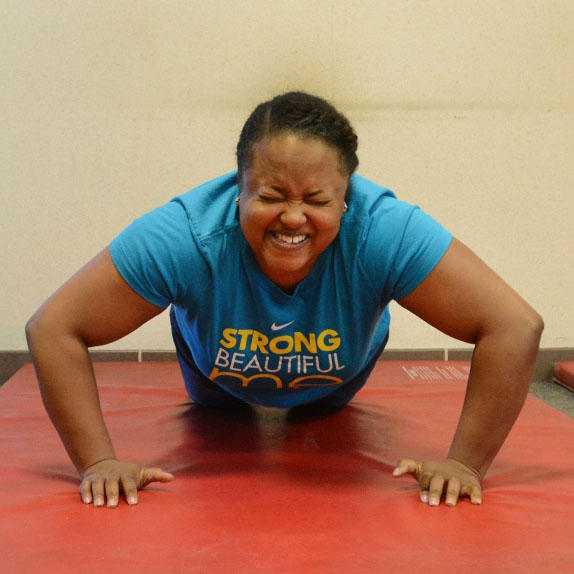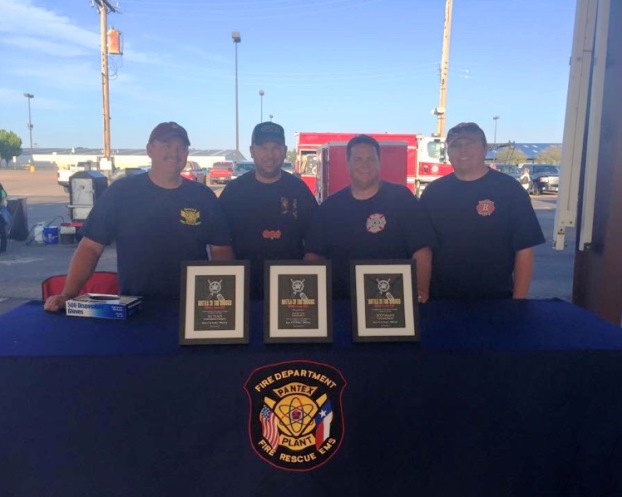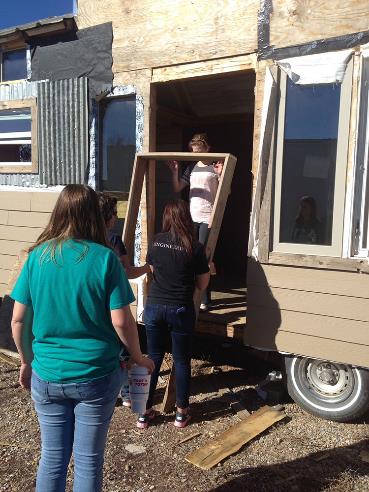Pantex Blog
Staying Active - for Life
More than 800 CNS employees participated in the Active for Life Challenge April 1–June 3. This 10-week program encourages people to be more active and eat healthier foods on a regular basis.
“It was terrific to see people out walking around the plant, in the gyms in town or participating in group activities during lunch,” Sherry Philyaw, Pantex Active for Life captain, said. “My favorite part was seeing people getting active and taking charge of their own health.”
Karen Lacey, LiveWise dietitian and Y-12 Active for Life captain, agreed. “I loved seeing our teams participating at the Secret City 5K and Relay for Life. Our multiple onsite challenges (longest plank, most pushups) encouraged some great competiveness between us and Pantex.”
The overall top CNS team was TEAM V, located at Pantex. This Active for Life team truly embodied the CNS OneTeam vision. Pantexan Marc Brooks explained, “While six of us are here at Pantex, one of your own (Eric White, who works at Pantex about 25 percent), was also a member of TEAM V. So, the top CNS team was a joint effort of Pantex and Y12 after all!”
While Pantex and Y12 didn’t place in the top category for the multi-lab challenge, CNS employees can be proud.
Lacey said, “CNS participants averaged over 46 minutes per day, which meets and exceeds recommendations for overall health and minimizing risk of chronic disease, and far exceeds national averages for activity. It thrills me to see these numbers!”
Lacey and Philyaw are already planning for next year’s campaign.

Allison Roberts was one of the more than 800 CNS employees who participated in Active for Life
Wild Pantex – It Rained Frogs and Toads
Article by Jim Ray, Pantex Wildlife Biologist/Scientist
I love this time of year because it is "thunderstorm season" here in the Texas High Plains. I am a weather buff, but I also fully appreciate the fact that rainfall is the lifeblood of our area's agriculture, and its wildlife's production and habitat.
I especially like the explosiveness of our playa wetlands in terms of how quickly they come to life following the collection of runoff from spring and summer rains. In fact, these ephemeral wetlands are considered some of the most productive of wetlands in the world. Within days of catching water, eggs that have lain dormant in the dry sediments hatch and the water teems with invertebrates such as freshwater shrimp, and even a species of freshwater sponge. Water-born insects such as dragonflies and midges also proliferate while surface water is available.
I often get questions this time of year about frogs and toads. Why did they appear all of a sudden and where did they come from?
All of a sudden toads are hopping around in our backyards and, depending on species present, playas may resonate, even to the point of a roar (Great Plains toads), with the choruses of frogs and toads. These choruses represent multitudes that have emerged from burrows in the surrounding uplands and raced to the nearby playa for an opportunity to breed. Due to the ephemeral nature of playas, the frogs and toads of the surrounding area may get multiple chances to breed through the years or they may only get a single opportunity in their lifetime.
We encounter the Great Plains toad and Woodhouse's toad in our yards quite frequently. Other species, although locally numerous, may only rarely emerge from their underground burrows. With thunder or wetness acting as a stimulus to bring them to the surface, they emerge and then off they race into the darkness to a nearby playa to perpetuate their species.
Along with West Texas A&M University subcontractors, We have documented 10 species of frogs and toads at Pantex including the aforementioned Great Plains and Woodhouse's toads, Plain's leopard frogs, bullfrogs, two species of chorus frogs, and four species of spadefoot toads. Visit http://herpsoftexas.org/view/frogs for information on the frogs and toads of Texas, including their distributions.

Dr. Richard Kazmaier (West Texas A&M University) samples tadpoles in an ephemeral pool of water at Pantex.
Education on Aisle Nine

Grocery shopping. Some people carefully plan a weekly menu and painstakingly make a list in an attempt to stick to their budget. Others dread the task so much they just show up at the store hungry, throw items in the cart and go home hoping to make a meal of their basket full of random purchases.
Regardless of which category they fit in, several Pantexans recently turned this mundane weekly task into a fun educational event.
The employees and some family members visited two local grocery stores for healthy shopping tours. The tours, hosted by Market Street United and Natural Grocers, were part of the Active for Life Challenge, a 10-week American Cancer Society program to encourage employees to be more active and eat healthier foods.
At Natural Grocers, the store manager and employees provided an aisle-by-aisle overview of many healthy food products and supplements. They talked about food philosophy and standards. The produce manager even cut a blood orange for participants to taste. Attendees also took home a new product sample and some literature from the store’s nutrition library.
Kelly Delgado-Goudschaal, manager of Pantex Supply Chain Management Transformation and Strategic Initiatives, was impressed by the store’s advice to gradually convert to a healthier lifestyle.
“The store manager encouraged us to make small changes instead of jumping off a cliff into health eating,” Delgado-Goudschaal said. “The prices were also not as expensive as I expected.”
She made the tour a family affair by bringing her wife and three daughters along. The kids said the samples offered during the tour were “not as gross as they expected”.
At Market Street United, a certified dietician offered a two-hour Easy Diabetes Shopping store tour designed to help diabetics make healthier shopping decisions.
Pantex Engineer Sharon Smith said, “The tour was fantastic! We learned how to use the special number on the price stickers to help us choose the healthier items”.
Those who couldn’t attend a store tour were encouraged to complete a grocery store scavenger hunt to learn about product placement and labeling.

Pantex Fire Department wins BBQ Competition

Pantex Fire Department members (left to right) David Stewart, Kyle Butler, Scott Johnson and Jeremy Baker won the 100 Club of the Texas Panhandle’s “Battle of the Badges” barbeque cook-off. The team donated their $1,000 cash prize back to the 100 Club.
The Pantex Fire Department recently participated in the 100 Club of the Texas Panhandle’s annual “Battles of the Badges” barbecue cook-off, a competition between Amarillo area law enforcement and firefighters.
Pantex firefighters won the grand championship for their brisket and placed seventh in
the ribs category. The team received award plaques and a cash prize of $1000, which
they donated back to the 100 Club. The winning team members were Scott Johnson,
battalion chief; David Stewart, captain; Kyle Butler, driver/operator; and Jeremy Baker,
firefighter/paramedic.
The 100 Club provides financial aid for families of public safety personnel who are
seriously injured or killed in the line of duty. In addition, as funds are available, the club
provides law enforcement and firefighting agencies with life-protecting equipment and
educational opportunities that cannot be secured through budgeted funds or agencies. It
serves the 26 Texas Panhandle counties.
A tiny house that STEMs from big hearts

CNS employees are teaching Girl Scouts valuable STEM skills while leading an Amarillo-wide effort to transform an old camper into a tiny home for a woman in need.
Don’t expect a lot of girl talk from Savannah Gates, Rebecca Heinen, Brandy Ramirez and Courtney Waddell. When they get together, they “do.” Naturally, when the Pantex engineers had the opportunity to share what a STEM education is all about with a group of Girl Scouts, they didn’t pull out the trusty (translate “dull”) PowerPoint presentation. They put tools in the girls’ hands and showed them instead.
“I didn’t get into engineering for the sake of engineering,” said Gates, a mechanical engineer who works in Production and Manufacturing Engineering. “I got an engineering degree because it’s the love of what I could do with it in my personal life. I am passionate about using my skills to make my community a better place to live.”
The four Pantexans have worked with local Girl Scout troops on several community improvement projects and engineering‑related activities. To encourage the girls to consider careers in science, technology, engineering and math, or STEM, the engineers involved them in building a “tiny house” to give them hands‑on STEM skills.
Tiny houses are part of a growing trend to lead a simpler, lower‑cost lifestyle, one that many times involves having a reduced ecological impact. Tiny houses are just that — small, usually less than 300 square feet. Some are off‑the‑grid, generating their own electricity, and capture rainwater. They can be portable or attached to slabs. Tiny homes are less expensive to build than larger‑scale homes and are easier and cheaper to maintain.
Gates, Heinen, Ramirez, Waddell and the Girl Scouts are working alongside Pantex carpenters, electricians and welders, who’ve donated their services, as well as city planning officials, community volunteers and businesses, which have contributed supplies, to transform an old camper into a tiny home for a woman in need.
Only 16 percent of American high school seniors are proficient in math and interested in a STEM career. Even among those who do go on to pursue a college major in STEM fields, only about half choose to work in a related career. The U.S. is falling behind internationally, ranking 25th in math and 17th in science among industrialized nations. Source: U.S. Department of Education |
“After hearing about the girls’ efforts from a local news story, our fellow Pantexans began to volunteer their supplies, time and skills to aid in this great cause. This is really an Amarillo‑wide effort spearheaded by Pantex,” said Heinen, who has a degree in industrial engineering. “The house, which is part of a larger community of planned tiny homes, will be for a single mom or woman coming from a poisonous environment, perhaps drug addiction or abuse.”
The Pantexans are teaching the Girl Scouts practical STEM skills through trade work. “We’re breaking away from the traditional STEM classroom approach,” Gates said. “The girls are installing doors and new windows. We’ve put tools in their hands and are showing them how to use them. They’re loving it.”
Imparting their engineering skills isn’t the only motivator for the engineers; they also want to mentor the girls on the importance of giving back to their communities.
“I am always excited to help others,” said Ramirez, a facility engineer in System Engineering. “This project presented a great opportunity to help others as well as teach young girls about engineering and construction. Having a part in building strong, smart, caring young women is very rewarding.”
Waddell, a mechanical engineer, agrees. “The best part of working with my Pantex colleagues is seeing how much love there is for our community,” she said. “The group is constantly looking for ways to give back, and this project is a perfect example of that.”
